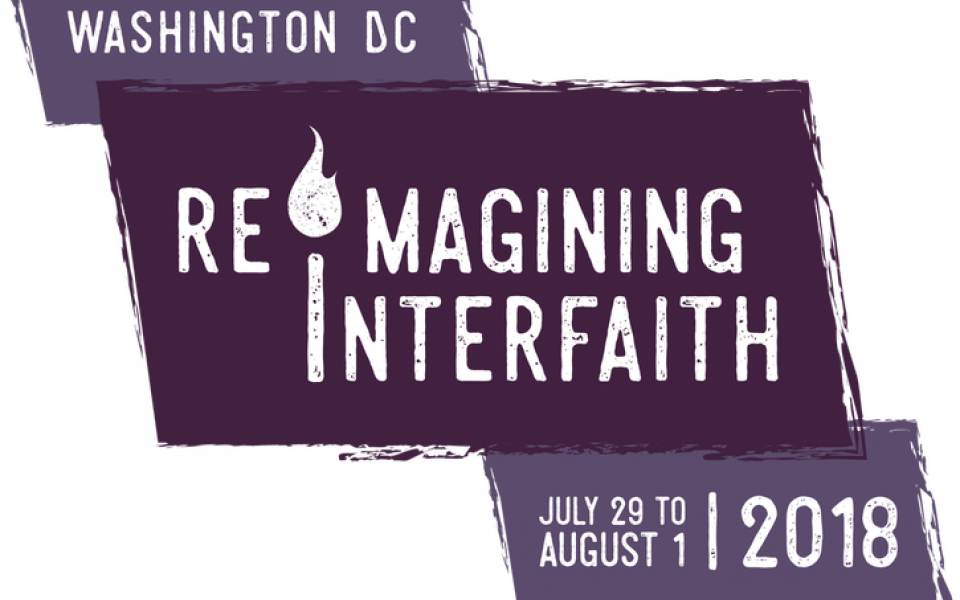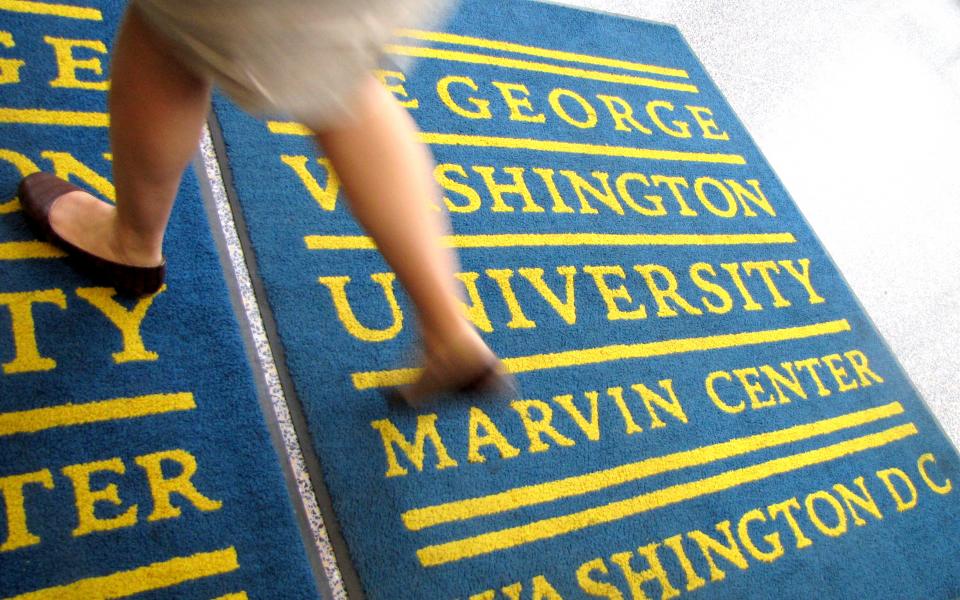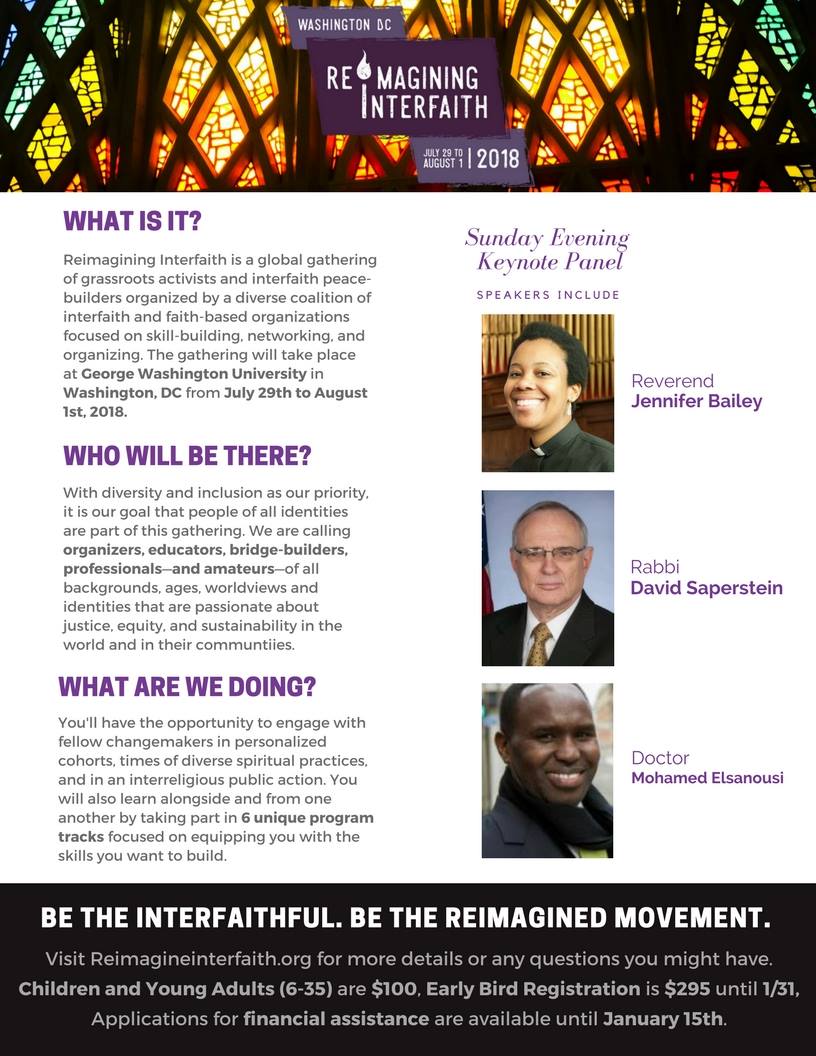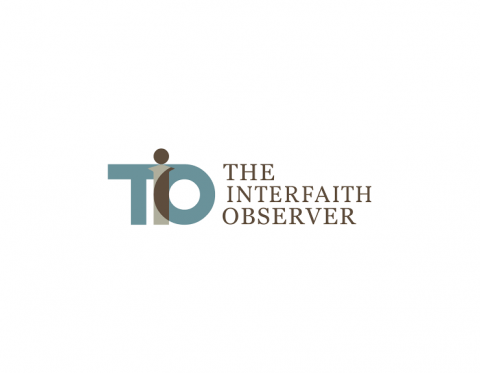Interfaith organizations, some of whom have never before worked together, join hands for an event to reimagine interfaith cooperation!

By Robyn Lebron
As many of you know United Religions Initiative is co-sponsoring a notable event that will be immediately following our North America Regional Assembly in July.
We are at a moment in world history where collaboration across lines of difference is imperative to our survival. There is much incredible work being done by grassroots organizers around the world but it’s time to take it to the next level. That is what Reimagining Interfaith Cooperation (RI) plans to do!
This innovative gathering came into being when the International Association for Religious Freedom (IARF) started planning for their 35th World Congress , which only happens once every four years. In cooperation with the Unitarian Universalist Association (UUA), which has been actively involved with IARF for many years, they decided to make the event bigger and better than ever!
The UUA began to reach out to other organizations in an effort to get the most benefit out of the event as possible. They decided that they needed to bring together a wider diversity of organizations who were involved in the interfaith space, and a broader coalition of faith communities to build something a little bit different. URI and several of our members, The Interfaith Observer, Green Faith, and the National Peace Academy, in addition to other groups including Religions for Peace-USA, Shoulder-to-Shoulder, the Interfaith Funders Group, the United Church of Christ and multiple other faith communities all got involved enthusiastically.
“The excitement grew very quickly,” exclaimed Eric Cherry, Convener of the Reimagining Interfaith Host Committee and representative for UUA. He strongly felt that some “movement-building is really what the times call for.” So he headed in the direction of an event that would support local interfaith activists from around the world -- an event that would help with skill-building and connections to resources and best practices.He continued “We’re not trying to create a new organization, we are trying to support ‘movement building’ and be a part of that movement, by bringing a larger piece to that project.”
The United Religions Initiative was one of the first organizations to sign on as a co-sponsors of the event.
“When IARF approached us about this partnership, we jumped in with both feet,” said Sari Heidenreich, who is URI’s North American Regional Coordinator and representative to Reimagining Interfaith. “One of the many things that has been so incredible about this process is the number of diverse organizations that have come together to plan it. Some of these organizations, though we have long had similar values, have never before worked together on this scale. And, the fact that we’re doing it now, is so important.”
Reimagining Interfaith has also been designated as an official Pathways to Parliament of World Religions pre-Parliament event.
The Reimagining Interfaith event (RI) is taking place at George Washington University in Washington DC from July 29 - August 1, 2018!
This will be a global gathering of both grassroots activists and interfaith peacebuilders, allowing them to connect and ascertain the ways that they can all move to the next level of engagement in their communities, in their countries and in the world. Reimagining Interfaith aims to engage us in questions about how we can better enlist all people and increase understanding and involvement, and bring us to a point where we can truly make the movement all-encompassing. Cherry’s enthusiasm was infectious as he described his vision for the event, “One of the most important things that can happen in the interfaith space is introducing people to each other; helping them to explore the actions that they are taking in their local communities, to learn from each other, and to build energy for further efforts. That’s what Reimagining Interfaith is all about. That work fills my heart with inspiration and with joy!”

Tahil Sharma is working on numerous administrative and logistical aspects of the conference. Sharma also works with the Episcopal Diocese of Los Angeles as an Interfaith Minister In Residence and as the Los Angeles Chair for Sadhana:A Coalition of Progressive Hindus. As a Reimagining Interfaith Fellow, Sharma is tasked with engaging the future generation of leaders by drawing in voices of the “under 35” age group.
"Folks under 35 are playing pretty substantial roles in how this conference develops," Sharma stated. "But it's something we hope to reflect in the attendance of folks as well." Young leaders under 35 are involved as conference planning fellows and as members of all committees for the programming and planning of the event. "We are central to many of the decisions made, although it's not without a deep dialogue to explain our approaches and suggestions to certain problems," Sharma added with pride.
Cherry enthusiastically added, “My belief is that there are leaders, as we speak, who will be at the forefront of future activities.”
Altogether, the conference planning team is made up of approximately 50 people, from diverse organizations, faith communities, races, nationalities, ages, socioeconomic statuses, and more, who are volunteering their time and energy to make this event happen.
Like Tahil, Cherry agreed that the process has been fulfilling and enlightening. Hearing the thoughts and concerns of such a variety of people has been empowering. As Cherry discussed his personal involvement in the planning process, he shared how the others that are involved strengthened his passion. For example, he described how, despite the culture of fear that is present in parts of the world, those involved in Reimagining Interfaith are talking about their hopes and dreams for inclusivity. That lifts him up and makes it easier to handle all that is involved in working for something he believes in.
“It has definitely been worth the energy, and I certainly will be involved in future efforts, because I am committed to this work,” Cherry insisted without hesitation.
He is inspired by the diversity of the people who have already registered, not only geographical, but the age, racial, ethnic and cultural diversity as well -- and the diversity of involvement in interfaith in general. Cherry went on to say that, among those attending the conference, are people new to interfaith, along with experts and people who have been involved for many years. He insisted that one is notis more important than the other, because we can all learn from each other.
Over the years, many interfaith gatherings have brought attendees closer to knowledge and understanding of other faith practices. Many have shared valuable information and even cultural experiences -- all of which are crucial to the total interfaith experience.

So HOW is "Reimagining Interfaith" different?
Cherry insisted that the other interfaith conferences are all wonderful events, but this event really will be different. Instead of lectures, panels and presentations, there will be experiential programs in which attendees will participate in the work that is being done in each session. A gathering size of under 500 attendees means participants experiences will be adaptive and hands on.
“Making our programs practical and relevant has been one of our main focuses throughout this entire planning process,” said Heidenreich, who is the co-chair of Reimagining Interfaith’s Program Committee. “For each session the team plans, we are asking ourselves, ‘What skills will participants walk away with?’”
Reimagining Interfaith is going to dive deep into ways to approach a diversity of interfaith actions and interactions. RI is focusing on the practical aspects of a “living faith,” not the academic or theological sides. There will be five powerful skill-building program areas, focused on equipping participants with trainings in community organizing, creating religiously-inclusive communities, interfaith organizing in a changing spiritual landscape, addressing race and privilege, and making interfaith into a movement. There will also be tracks focused on equipping participants with trainings in community organizing, creating religiously-inclusive communities, interfaith organizing in a changing spiritual landscape, addressing race and privilege, and making interfaith into a movement. There will also be a track for children. and blocks of time also set aside for open networking, dialogue groups, cultural activities and participant-driven programming. All of the programs will focus on equipping and empowering activists and peacebuilders, working across lines of contrasting thought with skills to move forward together.
Participants will learn skills, experiences and best practices that have worked for others. “It’s not academic learning -- it’s experiential learning through sharing what we’ve all been through in the trenches around the world,” Cherry explained. And afterward, they all will be doing some planning on how they can bring those experiences back to their communities. In addition to the skill-building sessions, there will be experiences that engage all parts of a person, such as starting and ending the days with spiritual focuses, circle groups of 10-12 people having conversations around a learning experience that has taken place in an earlier session, and cultural activities and events. The desire to open hearts and minds to sometimes difficult concepts is an essential part of the planning process.
“We really want people to walk away from this gathering, not only with the tools they need to be better interfaith activists, but as nourished, full people,” said Heidenreich. “That’s why we have integrated elements that focus on spirituality, relationship-building and, importantly, fun!”
What impressed Sharma the most about the conference plans is the ability for attendees to address so many “elephants in the room”-- addressing the idea that there are a variety of issues and identities we would typically avoid discussing or including in the narrative of the interfaith work. With thoughtfulness, Sharma added, "There's a deep desire to discuss the interfaith of religious and secular pluralism -- not as a monolithic movement but as a societal paradigm shift that affects all things. I want to engage [our] differences and discomfort equally to transform mindsets. And this conference is a real way of making that happen."
There was also a hint at what Cherry called an “Interreligious Public Action,” which will be a “chance to demonstrate a shared commitment to the power of the interfaith/interreligious movement and to do that publicly." This has generated a lot of excitement within the planning organizations and will take place on Tuesday, July 30th from 4 pm – 6 pm in front of the White House.
In fact, Sharma is looking forward to this particular part of the event the most. Conferences attendees will be taking part in a rally at Lafayette Park, with support and representation from numerous communities, to advocate for domestic and international issues of great pertinence. Sharma is clear about his hopes for the rally, "We want to end the fear and ignorance associated with the religious and secular ‘other’ and shift the global paradigm towards a more pluralistic narrative of knowledge sharing and productive collaboration between one another."
Cherry’s final thoughts were a heartfelt synopsis of what he thought Reimagining Interfaith would do for those who attend, “This is for people that are committed and involved in local interfaith activism. This is a chance to be together with other people with similar commitments and doing similar work, and simply by being together and exploring tools, experiences, [and] best practices -- we’ll have the chance to return to the work that we’re engaged in with more strength, more understanding, more power, [and] more relationships.” “I thoroughly hope that people who are doing the work locally – people who are often not recognized for [all] the ‘laboring in the vineyards’ that they do -- will come,” Cherry said stirringly. “Let us see you! Let us support you. Let us help you to take a next step in building a religiously inclusive community around the country and around the world!”
All are welcome. Register now!
This piece was written by URI North America Storytelling Intern Robyn Lebron. You can read more of her work here.

